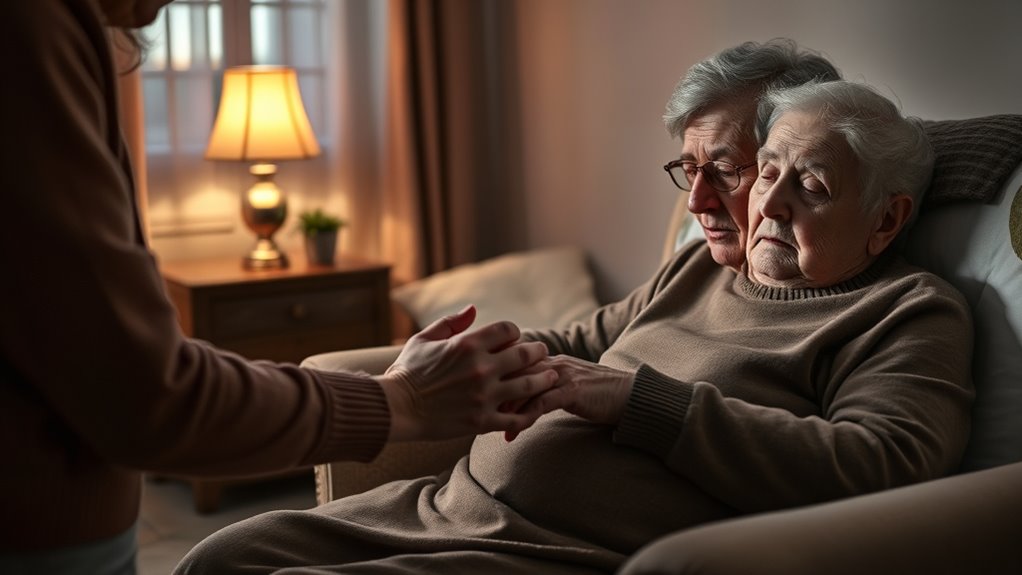To cope with sundowning, establish a calm evening routine using soothing activities and gentle lighting, and keep the environment quiet and safe to reduce overstimulation. Create familiar surroundings and use distractions like soft music or aromatherapy to ease agitation. Respond patiently to your loved one’s needs and seek support from caregivers or support groups. Prioritizing self-care is essential to maintain your resilience. If you want practical strategies for managing these challenges, there’s more to discover below.
Key Takeaways
- Establish a consistent, calming evening routine with soothing activities and dim lighting to reduce confusion and agitation.
- Create a safe, clutter-free environment with familiar furniture and gentle lighting to minimize overstimulation.
- Use sensory calming techniques like soft music, aromatherapy, and tactile activities to ease agitation and promote relaxation.
- Seek support from caregivers, support groups, and utilize resources to manage stress and enhance caregiving effectiveness.
- Prioritize self-care through regular breaks, hobbies, and physical activity to maintain resilience and emotional well-being.
Understanding Sundowning and Its Triggers
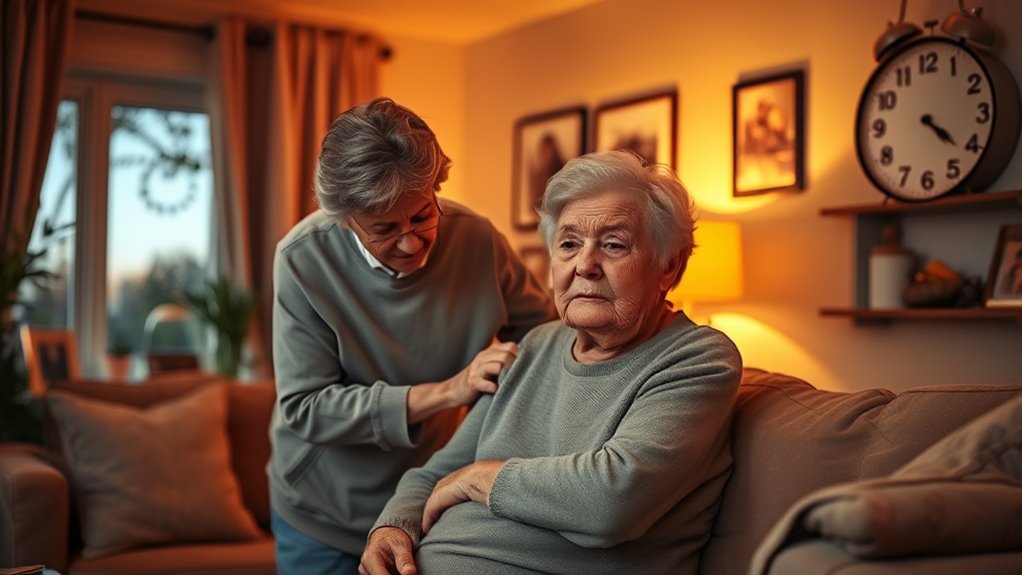
Sundowning is a common phenomenon where individuals with dementia become increasingly confused, agitated, or restless as evening approaches. This behavior is linked to changes in brain activity that disrupt the normal sleep cycle. As the day ends, the brain’s ability to regulate circadian rhythms weakens, causing confusion and heightened alertness. Reduced exposure to natural light can also throw off the sleep-wake balance, making it harder for the individual to settle down. Additionally, fatigue from daytime activities may intensify feelings of frustration. Recognizing that sundowning is related to these biological shifts helps you understand it’s not intentional but a result of how dementia affects brain function and sleep patterns. Understanding the connection between remote environments and brain activity can be crucial, especially when managing care in different settings. This understanding is essential for identifying triggers and managing symptoms effectively.
Establishing a Calm Evening Routine

Creating a calm evening routine can substantially reduce the agitation and confusion often experienced during sundowning. Start by establishing a consistent schedule, so your loved one knows what to expect. Incorporate calming activities like bedtime storytelling, which helps create a soothing atmosphere and signals that bedtime is near. Using aromatherapy relaxation, such as diffusing lavender or chamomile essential oils, can promote a sense of peace and reduce anxiety. Keep the environment quiet and dim the lights to avoid overstimulation. Avoid stressful conversations or exciting activities close to bedtime. A predictable, gentle routine helps your care receiver feel secure and relaxed, making it easier for them to transition into sleep. Incorporating skincare routines with gentle, soothing products can also contribute to a calming environment. Consistency and soothing rituals are key to minimizing sundowning symptoms.
Creating a Safe and Comfortable Environment
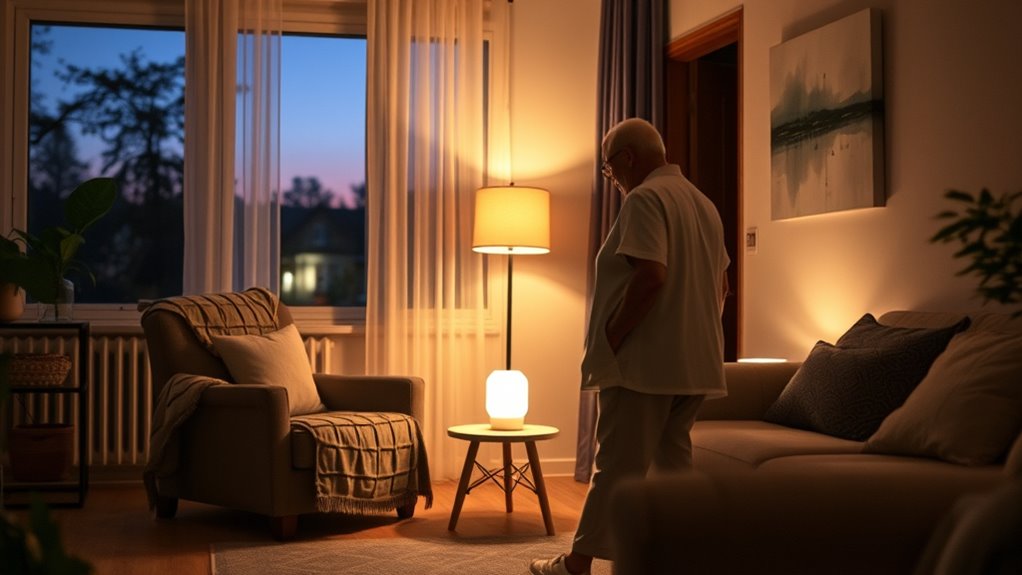
To create a safe and comfortable environment, start by arranging clear and open room layouts that minimize obstacles. Use soft, soothing lighting to reduce glare and create a calming atmosphere. These simple adjustments can help your care receiver feel more secure and relaxed during challenging times. Incorporating best anime movies can also provide comforting entertainment and distraction during difficult moments.
Clear Room Layouts
A well-organized room layout can make a significant difference in reducing confusion and promoting safety for care receivers experiencing sundowning. Clear pathways and designated spaces help prevent accidents and ease navigation. To achieve this: 1. Keep room organization simple by arranging furniture to create open, unobstructed walkways. 2. Control clutter by regularly removing unnecessary items and keeping surfaces tidy. 3. Use familiar furniture and avoid abrupt changes to maintain a consistent environment. Additionally, implementing safe and durable furniture can further enhance safety and comfort during nighttime hours.
Soft, Soothing Lighting
Soft, soothing lighting plays a vital role in making the environment safer and more comforting for care receivers experiencing sundowning. Gentle lighting reduces shadows and glare, aiding nighttime navigation and preventing falls. It also helps calm agitation and creates a familiar, reassuring atmosphere. To enhance safety and communication, consider using dim nightlights or lamps with warm bulbs. Incorporating automation technologies can further optimize lighting adjustments based on the time of day or activity, improving overall safety and comfort.
Utilizing Distraction and Engagement Techniques
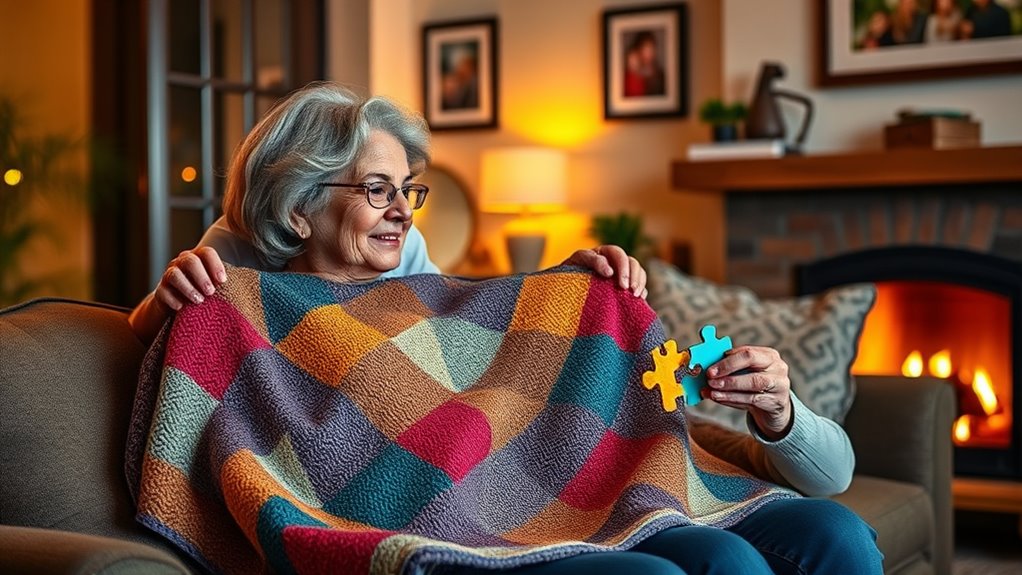
When your care receiver starts to become agitated, using distraction and engagement techniques can help calm them. Offer activities that capture their attention and redirect their focus away from distressing thoughts. By choosing the right activities, you can promote a sense of calm and reduce sundowning symptoms effectively.
Engaging Activities for Calm
Engaging activities that promote calmness can effectively redirect a care receiver’s attention during sundowning episodes. These activities help soothe agitation and foster relaxation. Consider these options:
- Play soft music therapy, such as gentle melodies or nature sounds, to create a calming atmosphere.
- Use aromatherapy techniques with diffusers or scented oils like lavender or chamomile to promote relaxation.
- Offer simple, tactile activities like folding towels or sorting objects to gently engage their mind without overstimulation.
- Incorporating AI-driven safety measures can help monitor and respond to unpredictable behaviors during sundowning episodes, enhancing overall care.
These approaches can help shift focus away from confusion or agitation, encouraging a peaceful mindset. Incorporating music therapy and aromatherapy techniques provides sensory comfort and can considerably reduce stress for both you and your loved one during challenging moments.
Redirecting Focus Effectively
Redirecting your loved one’s focus during sundowning episodes can considerably reduce agitation and help restore a sense of calm. Use emotional validation to acknowledge their feelings, showing understanding without confrontation. When they become distressed, gently redirect their attention to a different activity or object, providing sensory stimulation through touch, sound, or sight. For example, offer a soft blanket, play calming music, or introduce a familiar scent. Engaging them in simple tasks like sorting objects or looking at pictures can also help shift focus. The goal is to distract without dismissing their feelings, fostering trust and reassurance. Incorporating active listening techniques can further enhance communication and connection during these episodes. By combining emotional validation with sensory stimulation, you create a calming environment that diminishes anxiety and promotes a sense of security.
Managing Agitation and Restlessness Effectively
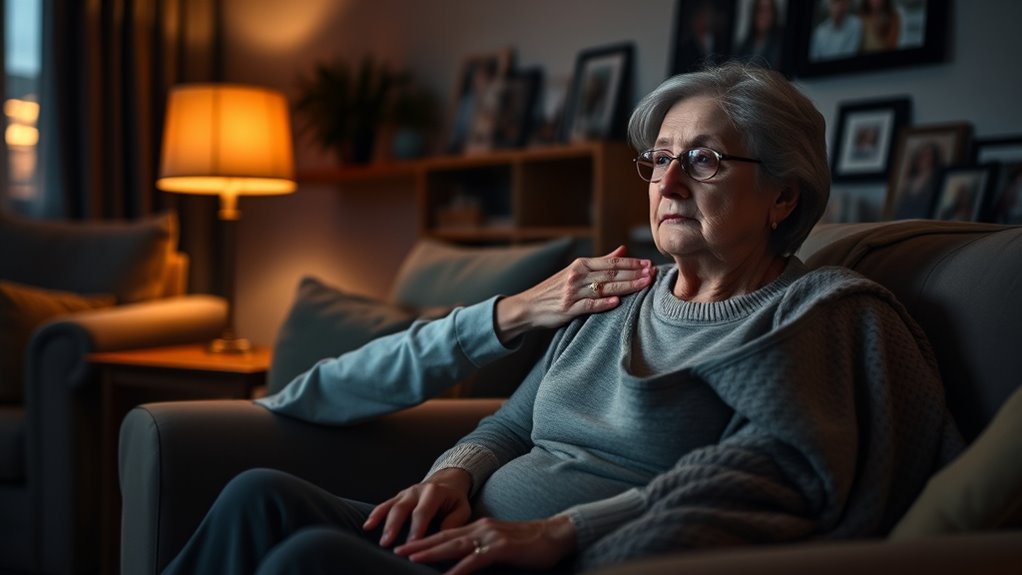
Managing agitation and restlessness during sundowning can be challenging, but implementing calming strategies can make a significant difference. First, establish a consistent routine to reduce confusion and anxiety. Second, communicate openly with your care receiver and healthcare providers to ensure appropriate medication management, adjusting dosages if necessary. Third, create a soothing environment by dimming lights, reducing noise, and providing comforting objects. Clear caregiver communication helps you respond quickly to signs of agitation, preventing escalation. Remember to stay calm and patient, as your tone influences your loved one’s mood. Incorporating calming techniques like gentle music or aromatherapy can further ease symptoms. These steps can help manage symptoms more effectively, making evenings calmer for both of you.
Seeking Support and Self-Care Strategies

Caring for a loved one experiencing sundowning can feel overwhelming, which is why seeking support and prioritizing self-care are essential. Connecting with emotional support networks, such as support groups or counseling, helps you share experiences and gain valuable advice. Don’t hesitate to ask family members or friends for help; you don’t have to face this alone. Practicing caregiver self-care is vital—set aside time for activities that rejuvenate you, whether exercise, hobbies, or relaxation techniques. Maintaining your mental and physical health enables you to better care for your loved one. Remember, caring for yourself isn’t selfish; it’s necessary to sustain your resilience and emotional well-being through this challenging time. Essential Resources and Tips for Caregivers and Seniors can also provide helpful guidance and support.
Frequently Asked Questions
How Can I Tell if Sundowning Symptoms Are Worsening?
To tell if sundowning symptoms are worsening, you should carefully track sleep patterns and note any changes. Look for increased agitation, confusion, or restlessness earlier in the evening. Identifying early signs, like heightened anxiety or pacing, helps you respond promptly. Keep a detailed journal to monitor progression, and consult your healthcare provider if symptoms become more intense or frequent, ensuring you can adjust care strategies effectively.
Are There Specific Medications to Help With Sundowning?
Imagine a quiet evening, and you notice your loved one’s restlessness intensifies. You wonder if medication options could ease their discomfort. While there are medications like antipsychotics or sleep aids that may help, you should consult a healthcare professional for prescription management. They can evaluate symptoms, recommend appropriate medications, and monitor effects, ensuring safe and effective treatment tailored to your care receiver’s needs.
How Do I Handle Aggressive Behavior During Sundowning Episodes?
When faced with aggressive behavior during sundowning episodes, you need effective aggression management strategies. Use calming techniques like gentle reassurance, soft voice, and distraction to soothe your loved one. Maintain a calm environment, avoid arguing, and give them space if needed. Recognize triggers, stay patient, and keep a routine to reduce agitation. These approaches help manage aggression and promote a sense of security during challenging moments.
What Dietary Changes Might Reduce Sundowning Symptoms?
You might find that adjusting your loved one’s diet helps reduce sundowning symptoms. Focus on consistent meal timing to stabilize blood sugar levels, which can influence agitation. Incorporate nutritional supplements like omega-3 fatty acids or melatonin, if advised by a healthcare professional, to promote better sleep and mood. Avoid caffeine and heavy meals close to bedtime, and guarantee they eat balanced, nutrient-rich foods throughout the day for overall stability.
When Should I Consider Professional Caregiving Assistance?
Thinking about when to seek professional caregiving assistance is like spotting storm clouds on the horizon. If your caregiver burnout feels overwhelming and emotional support isn’t enough, it’s time to contemplate help. You shouldn’t push through exhaustion alone. Professional care can ease your stress, provide specialized support, and ensure your loved one’s needs are met. Prioritizing this step protects your well-being and guarantees better care for your care receiver.
Conclusion
Remember, you’re the steady lighthouse guiding your loved one through the stormy dusk. By understanding triggers, creating calm routines, and offering reassurance, you anchor them safely as night falls. Your patience is the gentle beam piercing the dark, illuminating their path and soothing their fears. Though the waves of sundowning may rise, your compassion acts as the unwavering lighthouse, bringing hope and calm to both of you amid the night’s ebb and flow.
